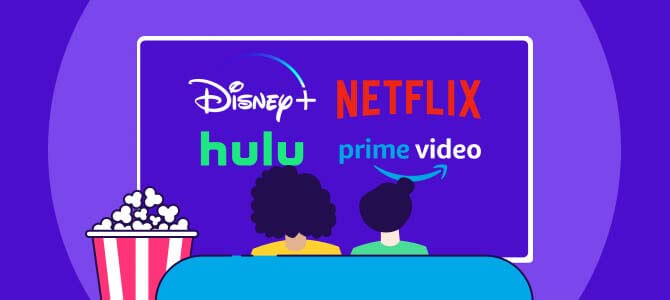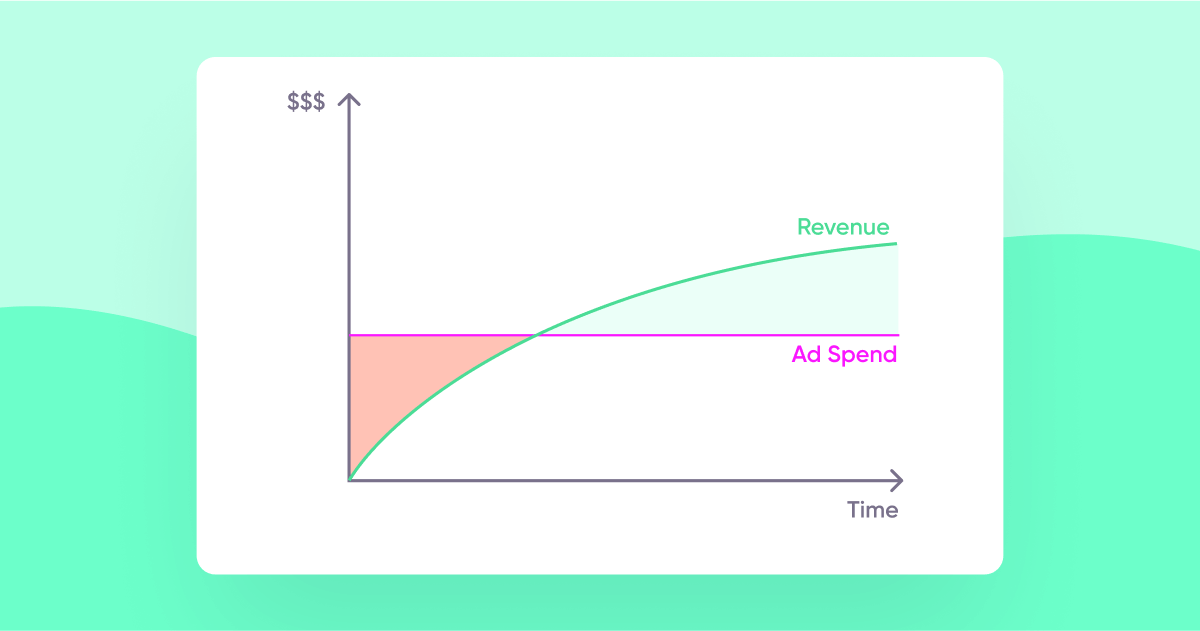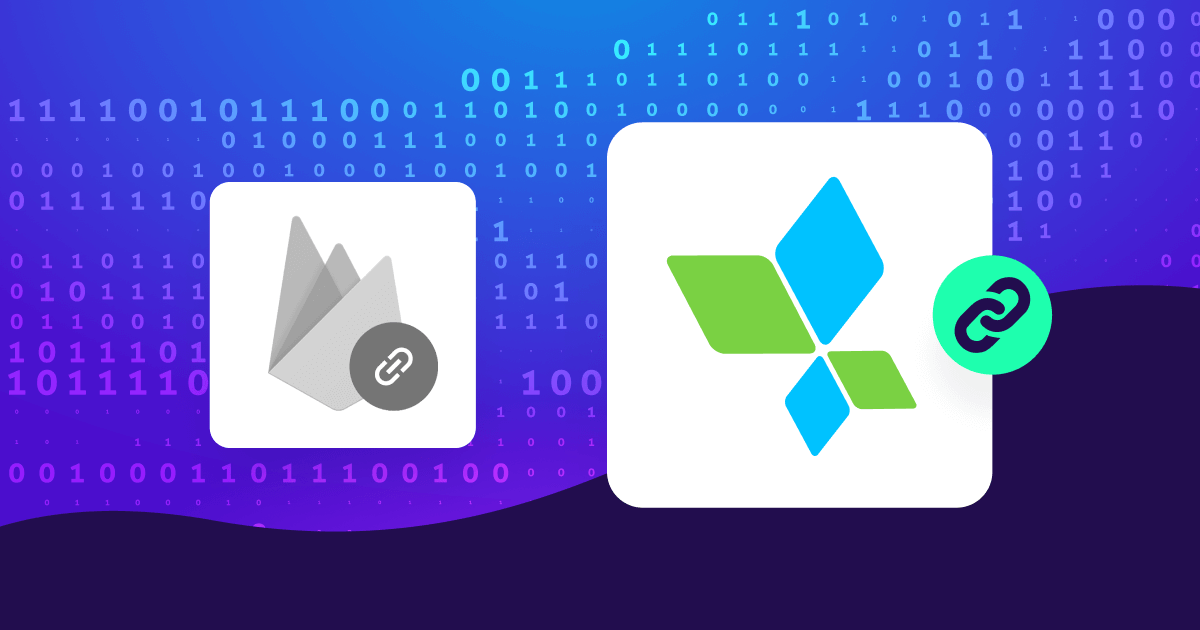
SVOD (Subscription Video on Demand)
A video monetization model, SVOD gives subscribers unlimited access to on-demand video content through platforms like Netflix, Disney+, and Amazon Prime in exchange for a small recurring fee.
What is SVOD?
Short for Subscription Video on Demand, SVOD is a popular OTT video monetization model where subscribers pay a flat subscription fee in return for unlimited access to a massive library of video content, ad free — think of it as a SaaS subscription, but for video content.
The subscription fee may be charged at any fixed interval but it is most often a monthly or annual payment. Once a user pays, they can watch as much content as they want for that period.
Aside from the platforms mentioned above, other major OTT platforms include HBO Max, Hulu, Paramount Plus, Showtime, Apple TV+, ESPN+, and Peacock. This type of model is so prevalent in the streaming industry due to the recurring nature of subscription fees (read: it’s predictable revenue which leads to higher LTV).
To give you an idea of how widespread the usage of SVOD as a monetization model in the OTT industry is, figure this — over 1.88 billion people (43.2% of internet users) use subscription OTT video services worldwide, and this number is only expected to grow.
Now, SVOD isn’t restricted to entertainment platforms like the ones mentioned above.
There’s a host of platforms running on an SVOD model for other genres like:
- eLearning
- eSports (gaming)
- Sports
- Fitness, health, and wellness
SVOD platforms are massively popular, so much so that it begs the question…
Can SVOD replace cable TV?

One in every three Americans is likely to cancel their cable TV subscription this year, and cable TV’s overall penetration rate has dropped to 71% from 88% in 2010.
This cord-cutting phenomenon is gaining pace all over the world thanks to:
- Availability of great content on SVOD platforms
- Affordability of subscription plans
- Blazing-fast internet speeds
- Increasing penetration of smart TV and smartphones
This phenomenon is compounded by ease of access provided by SVOD apps which allow subscribers to watch their favorite content on the go.
Even major smart TV operating systems like webOS (LG TV) and Tizen OS (Samsung) come with many preloaded SVOD OTT apps and the option to download more. This makes it easy for viewers to access them on their smart TVs.
It’s no surprise that nearly 85% of households in the US now access at least one SVOD service — much higher than the cable TV penetration rate.
With SVOD subscriptions continuing to grow at a breakneck pace and cable TV penetration consistently dropping, it’s safe to say that SVOD is eating into the market share of cable TV. However, SVOD may not replace cable TV entirely in the near future as it still commands a substantial market share as the preeminent legacy option for video and TV content consumption.
SVOD platforms
Some of the most popular video streaming OTT platforms monetize their on-demand content using SVOD. JustWatch, an international streaming guide, measures interest in SVOD services in over 100 countries. Here we can see their streaming performance review for Q2 of 2022 in the US:
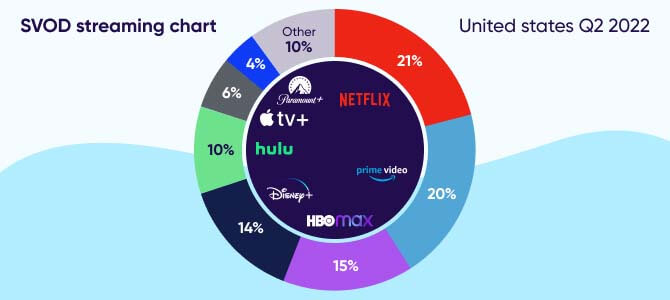
- Netflix: Leading the list of SVOD services in the United States, Netflix is still the most popular SVOD platform with 21% US market share. The subscription streaming service and production company giant that was founded in 1997 offers a great mix of original and curated content on the platform.
- Prime Video: This streaming platform from Amazon has a 20% US market share and offers an interesting collection of curated and original content.
- Disney+: The home to all movies and shows created by Disney, this platform has a 14% market share in the US.
- Hulu: With a 10% share in the US market,, this platform provides TV shows, movies, and live TV as well.
Looking toward the future, when examining new SVOD subscribers, Amazon Prime is the top destination followed by Disney+ and Apple TV+.
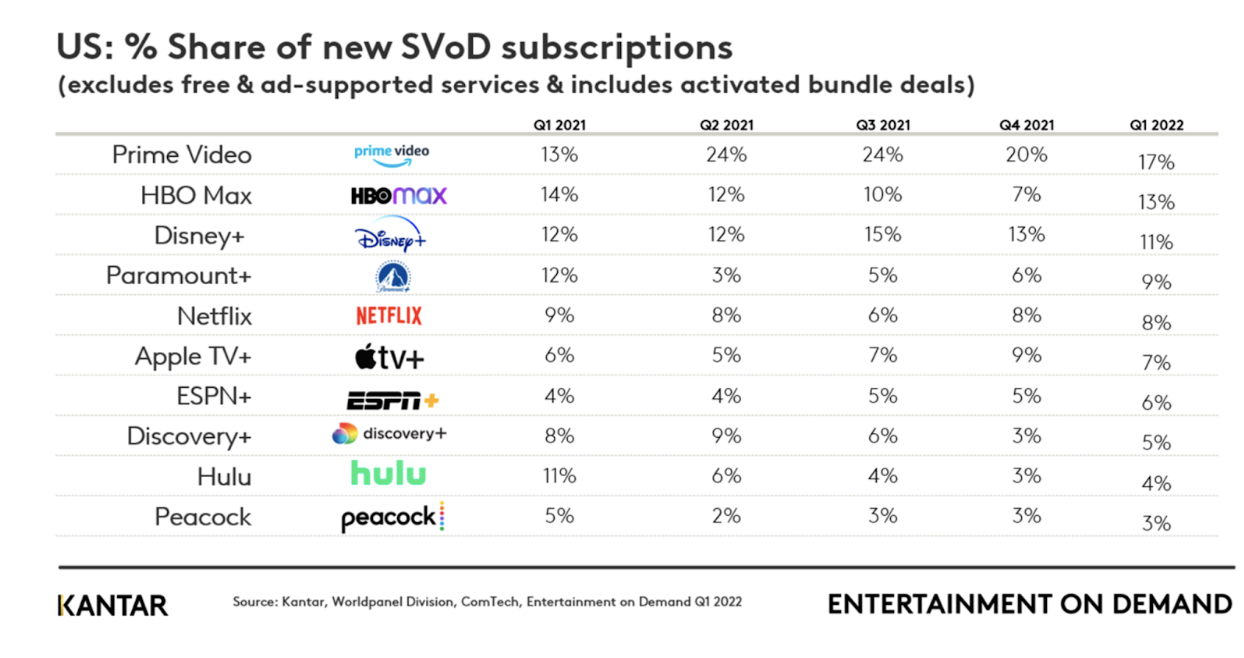
The advantages and disadvantages of SVOD
Advantages of SVOD
1 – Predictable, recurring revenue
Subscription revenue keeps coming month-over-month or year-over-year, which means you’ve got a guaranteed revenue stream to help run and grow your OTT platform.
2 – Pricing control
There are no pricing restrictions when it comes to SVOD models. You can choose to offer different pricing tiers, device-exclusive plans, or even varying plans based on the location you’re serving content in.
In a nutshell, your revenue is in your control and you can tweak it as you go according to ARPU and churn.
3 – Brand loyalty
When you create or curate content that resonates with a core group of users, or is only exclusively available through your platform, this will more often than not translate into loyal subscribers who also recommend your service to others.
So this means you can count on long-term recurring revenue as well as expansion of your user base (without you having to pay for it!).
Disadvantages of SVOD
1 – Potentially smaller user base
You may be losing out on users that prefer to watch content with ads in exchange for access to a platforms’ content (i.e. AVOD) rather than pay a recurring fee up front.
2 – Strong competition
The SVOD market is extremely competitive. This means not only do you have to be smart about pricing (because users may not be ready to pay for more than one subscription) you also have to make sure you are investing in providing fresh, quality content users will want to watch — both of which could ultimately eat into your revenue.
3 – More expensive to acquire new users
Brand loyalty and WOM can only go so far. Given the competitive ecosystem and ad-based options, users may not be as willing to switch to or pay for an additional streaming service and the cost of acquiring new users could be quite high.
SVOD vs. AVOD vs. TVOD
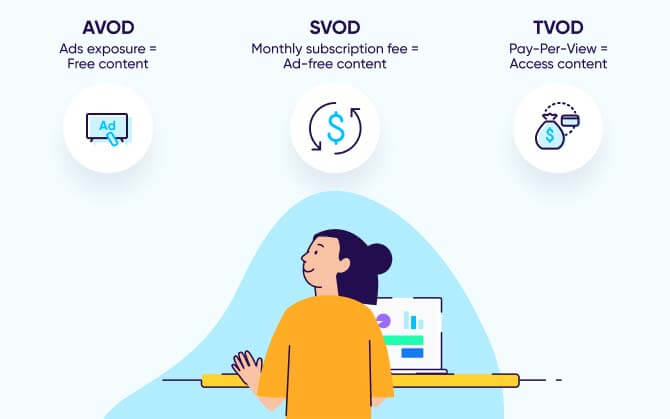
SVOD is one of the main monetization models for OTT platforms, with the others being AVOD and TVOD (Transactional Video on Demand).
Let’s understand how they’re different from SVOD.
AVOD
This monetization model works on payment from advertisers, while users get free access to the content they want for the “price” of watching an ad before or during a given video.
The platforms using an AVOD model appeal to a broader audience and have the most number of users (they’re free, after all). Examples include YouTube, Xumo, and Crackle.
TVOD
With Transactional Video on Demand (TVOD), as with AVOD, users can sign up to a platform for free, but they need to pay a one-time fee to rent or buy content.
For rented videos, there might be a fixed time window or cap on the number of times they can be viewed, while permanent access is usually given to purchased videos. This method is typically implemented for premium content like the latest movie releases and an example of a platform using this model would be Apple iTunes.
Is SVOD the right model for you?
Does the prospect of launching an SVOD platform sound exciting to you? Let’s figure out if it’s the right choice for your business.
Choose SVOD if you:
- Have an extensive or niche content library that would appeal to a particular section of viewers
- Possess the funds (and willingness) to invest in creating original content regularly to update your content library
- Can spend on campaigns to acquire new subscribers (and retain them)
- Are open to flexible subscription plans
- Are after a recurring income stream
- Don’t mind tracking complicated subscription business metrics
- Know users would be ready to pay subscription fees regularly to access your content
How to get started with SVOD
If all the conditions mentioned in the previous section are met, you’re good to start an SVOD for your platform. You can follow the below steps to get started::
- Select your niche and target audience as they determine the type of content you’ll need to add to your platform. Example: Entertainment, fitness, and sports.
- Select a video hosting platform with video APIs, security, cloud CDN, etc. Check if it lets you develop mobile and smart TV apps.
- Leverage multi-CDN architecture to provide consistent content delivery even if one CDN goes down.
- Start collecting and creating engaging content to be added to the platform.
- Build a subscription website and app on the selected platform.
- Encode your videos for adaptive bitrate streaming to provide a good video watching experience, irrespective of the network speeds.
- Secure your videos with DRM (Digital Rights Management) technology to curb piracy.
- Decide on your pricing plans and the level of access each plan provides.
- Set up a paywall for your videos to get visitors to subscribe to your platform to access the content.
- Market your SVOD platform to build a subscriber base.
Key takeaways
- SVOD is a video on demand monetization method used by platforms like Netflix and Disney+ that gives access to viewers in exchange for a fixed subscription fee for a particular period. It differs from AVOD (monetized through ads) and TVOD (monetized through fixed content fees for renting or buying).
- While it helps bring in recurring revenue, better control on pricing, and subscriber loyalty, it also means that you may lose customers to free AVOD platforms.
- You should consider SVOD only if you have an extensive library of niche content, are willing to spend in order to get and retain subscribers, and are open to flexible pricing plans.
